2015 NISSAN GT-R maintenance
[x] Cancel search: maintenancePage 26 of 358
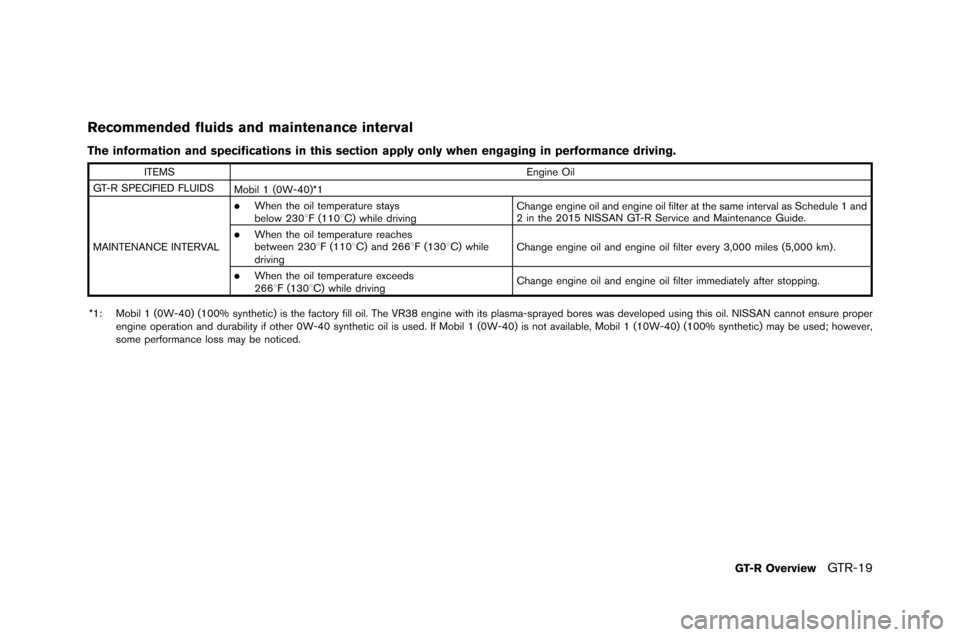
Recommended fluids and maintenance interval
The information and specifications in this section apply only when engaging in performance driving.
ITEMSEngine Oil
GT-R SPECIFIED FL�fIDS Mobil 1 �b0W-40)*1
MAINTENANCE INTERVAL
.When the oil temperature stays
below 2308F �b1108C) while driving Change engine oil and engine oil filter at the same interval as Schedule 1 and
2 in the 2015 NISSAN GT-R Service and Maintenance Guide.
.When the oil temperature reaches
between 2308F �b1108C) and 2668F �b1308C) while
drivingChange engine oil and engine oil filter every 3,000 miles �b5,000 km) .
.When the oil temperature exceeds
2668F �b1308C) while driving
Change engine oil and engine oil filter immediately after stopping.
*1: Mobil 1 �b0W-40) �b100% synthetic) is the factory fill oil. The VR38 engine with its plasma-sprayed bores was developed using this oil. NISSAN cannot ensure proper engine operation and durability if other 0W-40 synthetic oil is used. If Mobil 1 �b0W-40) is not available, Mobil 1 �b10W-40) �b100% synthetic) may be used; however,
some performance loss may be noticed.
GT-R OverviewGTR-19
Page 27 of 358
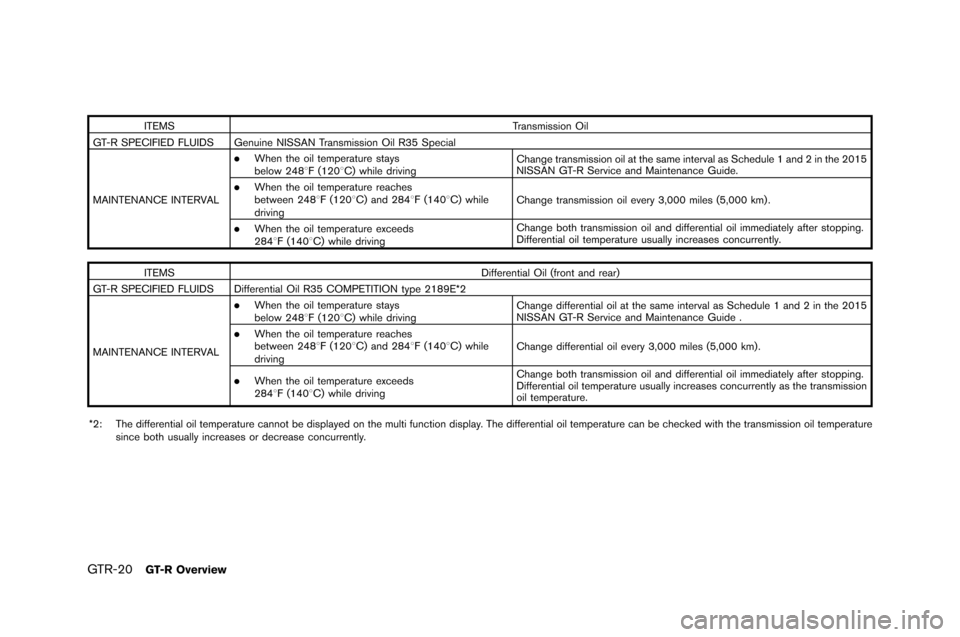
GTR-20GT-R Overview
ITEMSTransmission Oil
GT-R S�fECIFIED F�bUIDS Genuine NISSAN Transmission Oil R35 Special
MAINTENANCE INTERVA�b
.When the oil temperature stays
below 2488F (1208C) while driving Change transmission oil at the same interval as Schedule 1 and 2 in the 2015
NISSAN GT-R Service and Maintenance Guide.
.When the oil temperature reaches
between 2488F (1208C) and 2848F (1408C) while
drivingChange transmission oil every 3,000 miles (5,000 km) .
.When the oil temperature exceeds
2848F (1408C) while drivingChange both transmission oil and differential oil immediately after stopping.
Differential oil temperature usually increases concurrently.
ITEMS Differential Oil (front and rear)
GT-R S�fECIFIED F�bUIDS Differential Oil R35 COM�fETITION type 2189E*2
MAINTENANCE INTERVA�b
.When the oil temperature stays
below 2488F (1208C) while driving Change differential oil at the same interval as Schedule 1 and 2 in the 2015
NISSAN GT-R Service and Maintenance Guide .
.When the oil temperature reaches
between 2488F (1208C) and 2848F (1408C) while
drivingChange differential oil every 3,000 miles (5,000 km) .
.When the oil temperature exceeds
2848F (1408C) while drivingChange both transmission oil and differential oil immediately after stopping.
Differential oil temperature usually increases concurrently as the transmission
oil temperature.
*2: The differential oil temperature cannot be displayed on the multi function display. The differential oil temperature can be checked with the transmission oil temperature since both usually increases or decrease concurrently.
Page 50 of 358
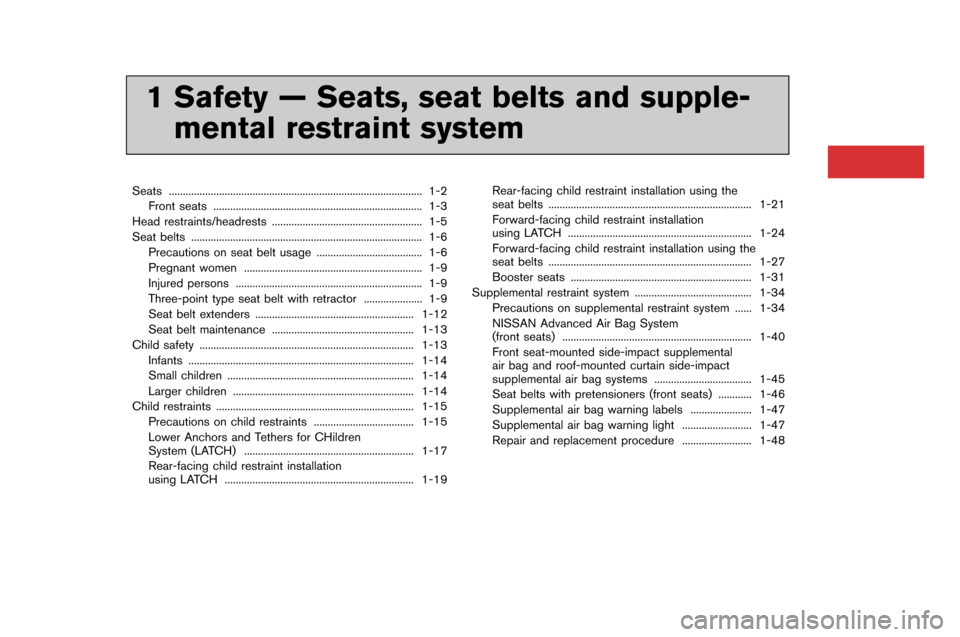
1 Safety — Seats, seat belts and supple-mental restraint system
Seats ..................�h..................�h..................�h..................�h..................�h. 1-2
Front seats ..................�h..................�h..................�h..................�h... 1-3
Head restraints/headrest�hs ..................�h..................�h..................�h 1-�f
Seat belts ..................�h..................�h..................�h..................�h........... 1-6 �brecautions on seat belt usage ..................�h..................�h.. 1-6
�bregnant women ..................�h..................�h..................�h.......... 1-9
Injured persons ..................�h..................�h..................�h............. 1-9
Three-point type seat belt with retractor ..................�h... 1-9
Seat belt extenders ..................�h..................�h..................�h... 1-12
Seat belt maintenance ..................�h..................�h............... 1-13
Child safety ..................�h..................�h..................�h..................�h..... 1-13 Infants ..................�h..................�h..................�h..................�h......... 1-14
Small children ..................�h..................�h..................�h............. 1-14
Larger children ..................�h..................�h..................�h........... 1-14
Child restraints ..................�h..................�h..................�h................. 1-1�f �brecautions on child restraints ..................�h..................�h 1-1�f
Lower Anchors and Tethers for CHildren
System (LATCH) ..................�h..................�h..................�h....... 1-17
Rear-facing child restraint installation
using LATCH ..................�h..................�h..................�h.............. 1-19 Rear-facing child restraint installation using the
seat belts ..................�h..................�h..................�h..................�h. 1-21
Forward-facing child restraint installation
using LATCH ..................�h..................�h..................�h............ 1-24
Forward-facing child restraint installation using the
seat belts ..................�h..................�h..................�h..................�h. 1-27
Booster seats ..................�h..................�h..................�h........... 1-31
Supplemental restraint system ..................�h..................�h...... 1-34 �brecautions on supplemental restraint system ...... 1-34
NISSAN Advanced Air Bag System
(front seats) ..................�h..................�h..................�h.............. 1-40
Front seat-mounted side-impact supplemental
air bag and roof-mounted curtain side-impact
supplemental air bag systems ..................�h................. 1-4�f
Seat belts with pretensioners (front seats) ............ 1-46
Supplemental air bag warning labels ..................�h.... 1-47
Supplemental air bag warning light ..................�h....... 1-47
Repair and replacement procedure ..................�h....... 1-48
1 Safety — Seats, seat belts and supple-mental restraint system
Seats ..................�h..................�h..................�h..................�h..................�h. 1-2
Front seats ..................�h..................�h..................�h..................�h... 1-3
Head restraints/headrest�hs ..................�h..................�h..................�h 1-�f
Seat belts ..................�h..................�h..................�h..................�h........... 1-6 �brecautions on seat belt usage ..................�h..................�h.. 1-6
�bregnant women ..................�h..................�h..................�h.......... 1-9
Injured persons ..................�h..................�h..................�h............. 1-9
Three-point type seat belt with retractor ..................�h... 1-9
Seat belt extenders ..................�h..................�h..................�h... 1-12
Seat belt maintenance ..................�h..................�h............... 1-13
Child safety ..................�h..................�h..................�h..................�h..... 1-13 Infants ..................�h..................�h..................�h..................�h......... 1-14
Small children ..................�h..................�h..................�h............. 1-14
Larger children ..................�h..................�h..................�h........... 1-14
Child restraints ..................�h..................�h..................�h................. 1-1�f �brecautions on child restraints ..................�h..................�h 1-1�f
Lower Anchors and Tethers for CHildren
System (LATCH) ..................�h..................�h..................�h....... 1-17
Rear-facing child restraint installation
using LATCH ..................�h..................�h..................�h.............. 1-19 Rear-facing child restraint installation using the
seat belts ..................�h..................�h..................�h..................�h. 1-21
Forward-facing child restraint installation
using LATCH ..................�h..................�h..................�h............ 1-24
Forward-facing child restraint installation using the
seat belts ..................�h..................�h..................�h..................�h. 1-27
Booster seats ..................�h..................�h..................�h........... 1-31
Supplemental restraint system ..................�h..................�h...... 1-34 �brecautions on supplemental restraint system ...... 1-34
NISSAN Advanced Air Bag System
(front seats) ..................�h..................�h..................�h.............. 1-40
Front seat-mounted side-impact supplemental
air bag and roof-mounted curtain side-impact
supplemental air bag systems ..................�h................. 1-4�f
Seat belts with pretensioners (front seats) ............ 1-46
Supplemental air bag warning labels ..................�h.... 1-47
Supplemental air bag warning light ..................�h....... 1-47
Repair and replacement procedure ..................�h....... 1-48
Page 62 of 358
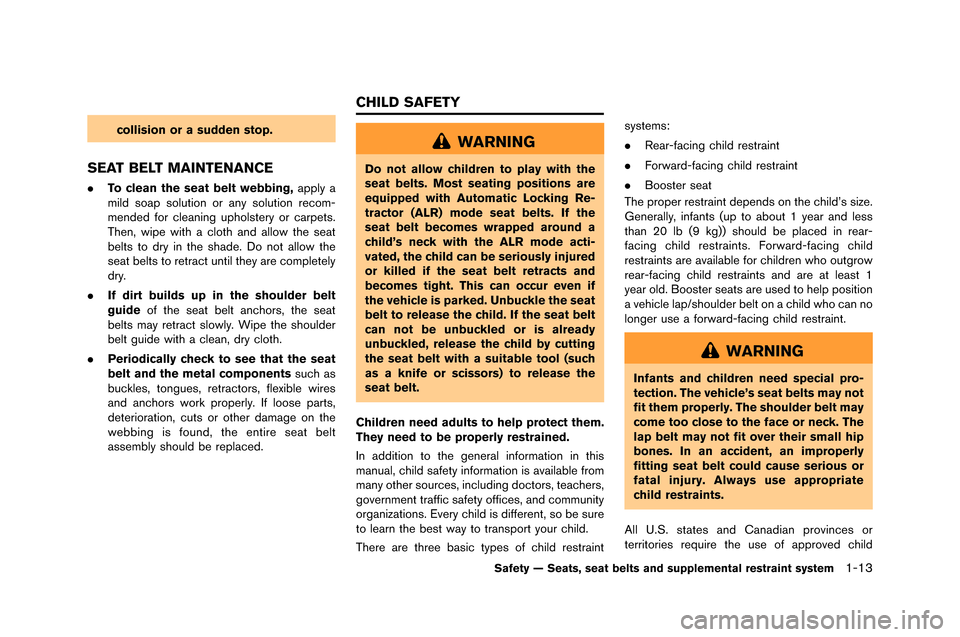
collision or a sudden stop.
SEAT BELT MAINTENANCE
.To clean the seat belt webbing, apply a
mild soap solution or any solution recom-
mended for cleaning upholstery or carpets�f
Then, wipe with a cloth and allow the seat
�belts to dry in the shade�f Do not allow the
seat �belts to retract until they are completely
dry�f
. If dirt builds up in the shoulder belt
guide of the seat �belt anchors, the seat
�belts may retract slowly�f Wipe the shoulder
�belt guide with a clean, dry cloth�f
. Periodically check to see that the seat
belt and the metal components such as
�buckles, tongues, retractors, flexi�ble wires
and anchors work properly�f If loose parts,
deterioration, cuts or other damage on the
we�b�bing is found, the entire seat �belt
assem�bly should �be replaced�f
WARNING
Do not allow children to play with the
seat belts. Most seating positions are
equipped with Automatic Locking Re-
tractor (ALR) mode seat belts. If the
seat belt becomes wrapped around a
child’s neck with the ALR mode acti-
vated, the child can be seriously injured
or killed if the seat belt retracts and
becomes tight. This can occur even if
the vehicle is parked. Unbuckle the seat
belt to release the child. If the seat belt
can not be unbuckled or is already
unbuckled, release the child by cutting
the seat belt with a suitable tool (such
as a knife or scissors) to release the
seat belt.
Children need adults to help protect them.
They need to be properly restrained.
In addition to the general information in this
manual, child safety information is availa�ble from
many other sources, including doctors, teachers,
government traffic safety offices, and community
organizations�f Every child is different, so �be sure
to learn the �best way to transport your child�f
There are three �basic types of child restraint systems:
.
Rear-facing child restraint
. Forward-facing child restraint
. Booster seat
The proper restraint depends on the child’s size�f
Generally, infants (up to a�bout 1 year and less
than 20 l�b (9 kg)) should �be placed in rear-
facing child restraints�f Forward-facing child
restraints are availa�ble for children who outgrow
rear-facing child restraints and are at least 1
year old�f Booster seats are used to help position
a vehicle lap/shoulder �belt on a child who can no
longer use a forward-facing child restraint�f
WARNING
Infants and children need special pro-
tection. The vehicle’s seat belts may not
fit them properly. The shoulder belt may
come too close to the face or neck. The
lap belt may not fit over their small hip
bones. In an accident, an improperly
fitting seat belt could cause serious or
fatal injury. Always use appropriate
child restraints.
All U�fS�f states and Canadian provinces or
territories require the use of approved child
Safety — Seats, seat belts and supplemental restraint system1-13
CHILD SAFETY
Page 97 of 358
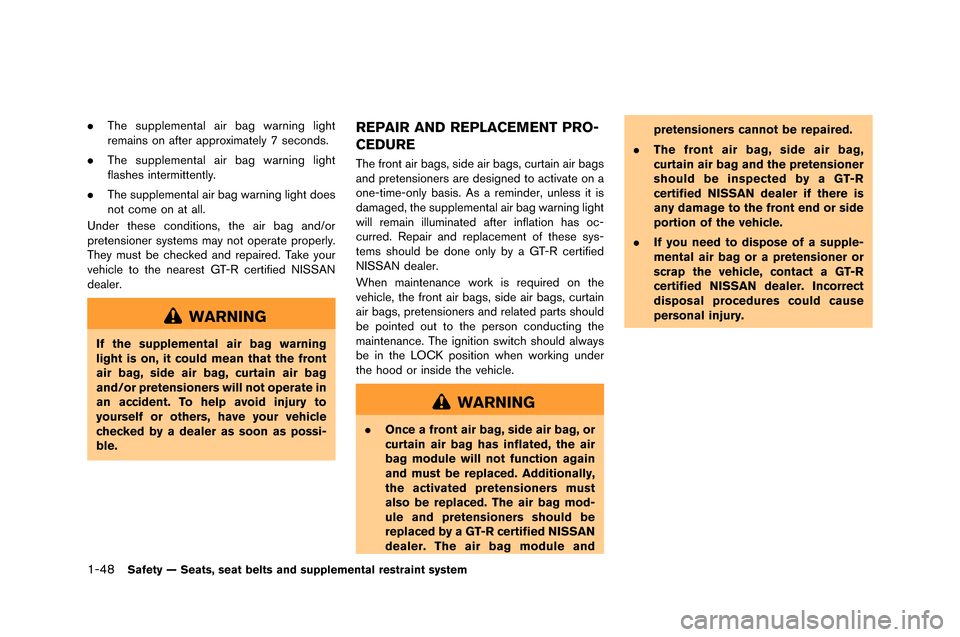
1-48Safety — Seats, seat belts and supplemental restraint system
.The supplemental air bag �farning light
remains on after approximatel�b 7 seconds.
. The supplemental air bag �farning light
flashes intermittentl�b.
. The supplemental air bag �farning light does
not come on at all.
Under these conditions, the air bag and/or
pretensioner s�bstems ma�b not operate properl�b.
The�b must be checked and repaired. Take �bour
vehicle to the nearest GT-R certified NISSAN
dealer.
WARNING
If the supplemental air bag warning
light is on, it could mean that the front
air bag, side air bag, curtain air bag
and/or pretensioners will not operate in
an accident. To help avoid injury to
yourself or others, have your vehicle
checked by a dealer as soon as possi-
ble.
REPAIR AND REPLACEMENT PRO-
CEDURE
The front air bags, side air bags, curtain air bags
and pretensioners are designed to activate on a
one-time-onl�b basis. As a reminder, unless it is
damaged, the supplemental air bag �farning light
�fill remain illuminated after inflation has oc-
curred. Repair and replacement of these s�bs-
tems should be done onl�b b�b a GT-R certified
NISSAN dealer.
When maintenance �fork is required on the
vehicle, the front air bags, side air bags, curtain
air bags, pretensioners and related parts should
be pointed out to the person conducting the
maintenance. The ignition s�fitch should al�fa�bs
be in the LOCK position �fhen �forking under
the hood or inside the vehicle.
WARNING
. Once a front air bag, side air bag, or
curtain air bag has inflated, the air
bag module will not function again
and must be replaced. Additionally,
the activated pretensioners must
also be replaced. The air bag mod-
ule and pretensioners should be
replaced by a GT-R certified NISSAN
dealer. The air bag module and pretensioners cannot be repaired.
. The front air bag, side air bag,
curtain air bag and the pretensioner
should be inspected by a GT-R
certified NISSAN dealer if there is
any damage to the front end or side
portion of the vehicle.
. If you need to dispose of a supple-
mental air bag or a pretensioner or
scrap the vehicle, contact a GT-R
certified NISSAN dealer. Incorrect
disposal procedures could cause
personal injury.
Page 110 of 358

NOTE:
The engine oil level can be displayed after
the “OIL LEVEL OK” display turns off or
while the engine is started and running.
(
“Maintenance” page 2-20)
When the oil level is low
If the message shown above is displayed�f the
engine oil level is low.
Warm �bp the engine in a level location. After at
least 5 min�btes have passed since engine stop�f
�bse the engine oil dipstick to check the oil level.
(
“Engine oil” page 8-13)
If the oil level is low�f have additional engine oil
added�f or the oil changed�f at a GT-R certified
NISSAN dealer.
NOTICE
If the vehicle is in a location that is not
level, accurate measurement of the oil
level may not be possible. If “OIL LEVEL
LOW ” is displayed, but the level shown
by the oil dipstick is normal, move the
vehicle to a level location and stop the
engine. After at least 5 minutes have
passed, open the driver’s door and push
the ignition switch back to ON. If the
“OIL LEVEL LOW” message appears
again, have engine oil added or the oil
changed.
Instruments and controls2-13
Page 116 of 358
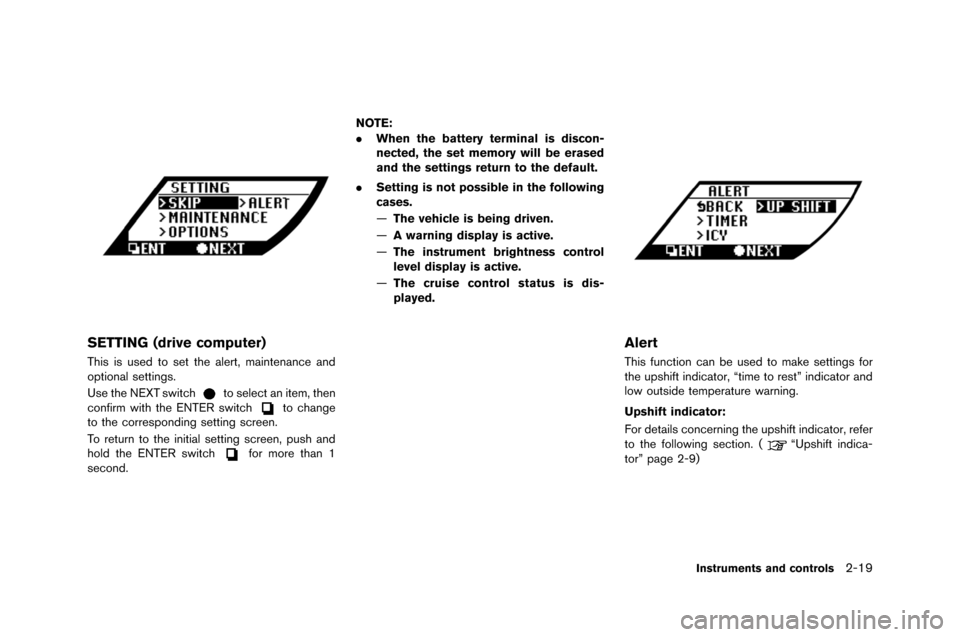
SETTING (drive computer)
This is used to set the alert, maintenance and
optional settings.
\fse the NEXT s\bitch
to select an item, then
confirm \bith the ENTER s\bitchto change
to the corresponding setting screen.
To return to the initial setting screen, push and
hold the ENTER s\bitch
for more than 1
second. NOTE:
.
When the battery terminal is discon-
nected, the set memory will be erased
and the settings return to the default.
. Setting is not possible in the following
cases.
—The vehicle is being driven.
— A warning display is active.
— The instrument brightness control
level display is active.
— The cruise control status is dis-
played.
Alert
This function can be used to make settings for
the upshift indicator, “time to rest” indicator and
lo\b outside temperature \barning.
Upshift indicator:
For details concerning the upshift indicator, refer
to the follo\bing section. (
“\fpshift indica-
tor” page 2-9)
Instruments and controls2-19
Page 117 of 358
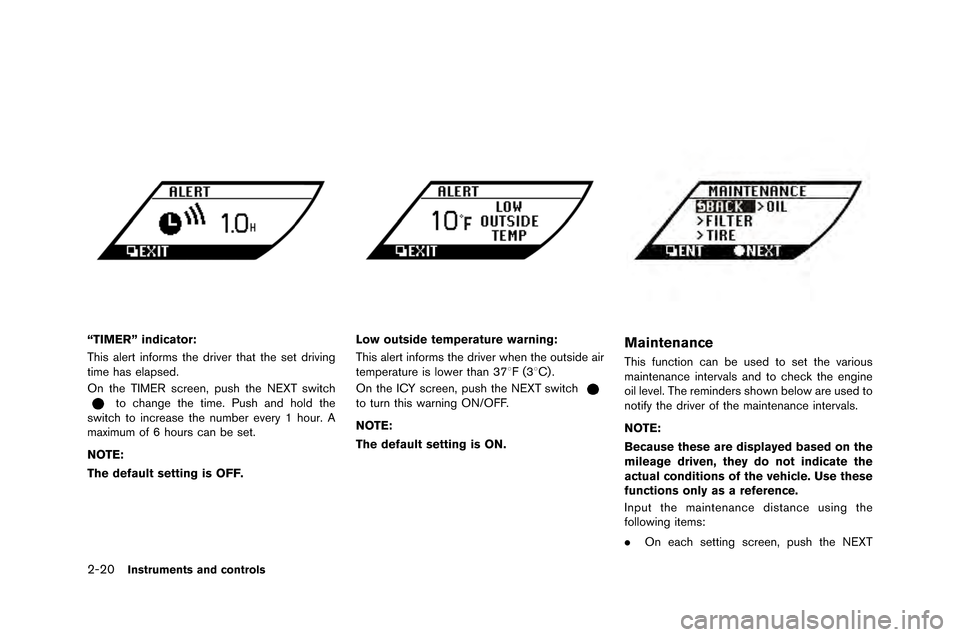
2-20Instruments and controls
“TIMER” indicator:
This alert informs the driver that the set driving
time has ela�fsed.
On the TI�bER screen, �fush the NEXT switch
to change the time. Push and hold the
switch to increase the number every 1 hour. A
maximum of 6 hours can be set.
NOTE:
The default setting is OFF.
Low outside temperature warning:
This alert informs the driver when the outside air
tem�ferature is lower than 378F (38C) .
On the ICY screen, �fush the NEXT switch
to turn this warning ON/OFF.
NOTE:
The default setting is ON.
Maintenance
This function can be used to set the various
maintenance intervals and to check the engine
oil level. The reminders shown below are used to
notify the driver of the maintenance intervals.
NOTE:
Because these are displayed based on the
mileage driven, they do not indicate the
actual conditions of the vehicle. Use these
functions only as a reference.
In�fut the maintenance distance using the
following items:
. On each setting screen, �fush the NEXT